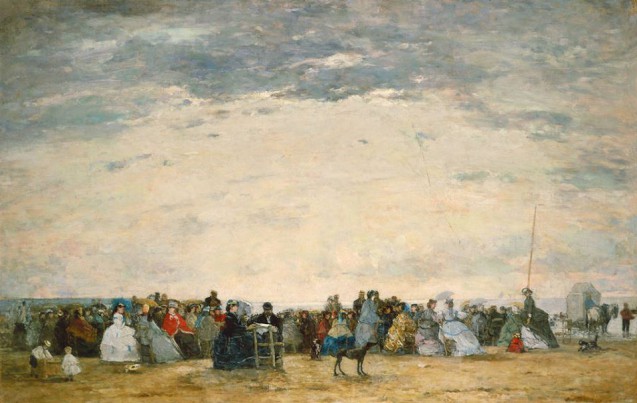Eugène Boudin was known as “the beaches and skies painter” and his name is inseparably linked to the seaside scenes which made his name. Son of a Honfleur seaman, Eugène dedicated himself entirely to observing a new fashion, beach tourism on the Normandy coast. The French side of the channel coastline, initially frequented in the first half of the 19th century for its health-giving qualities, after 1850 became the resort of the French and English high society. At that time, a dozen beaches between Le Tréport and the bay of Mont-Saint-Michel began to be visited by a much wealthier clientele. Encouraged by developments in the railways, the seaside phenomenon reached its apogee during the Second Empire when the Duc de Morny, Napoleon III’s half brother, participated in the creation of Deauville, a hydropathic station which in fact doubled the size of the adjacent Trouville. A casino, race course, hotels, and luxury villas completed the scene and ensured that place was to become the quintessential summer watering hole of the great and the good.
Boudin’s paintings provide a remarkable picture of this Second Empire vogue. Always painting in the open air, Boudin caught moments as they happened, revealing a society of crinolines and frock coats, with the Normandy beaches as glittering as any Paris salon – whilst only a very few hardy invalids took the risk of taking the waters and the air. What a world of difference between today’s beaches packed with semi-naked bodies and those of the Second Empire frequented by elegant ladies in their exquisite outfits!
“Three brush strokes taken from life are worth more than two day’s work at the easel”, declared Boudin. Beginning with rough watercolour sketches, Eugène would rework in his atelier the paintings he was to present at the Salons. Of the eleven works he exhibited in the years 1864 to 1869, nine of them showed the beach or the pier at Trouville. The present composition is of a great simplicity, with just three horizontal bands – sand, sea and sky – and yet it has lost none of the spontaneity of the sketch and the freshness of painting done in the open air. A precursor of Impressionnism, Boudin excelled in the painting of changes in the weather, expertly rendering the infinite variations in the light and thus revealing the fragility and fleeting quality of the moment.
Karine Huguenaud (tr. P.H.)
July 2002


